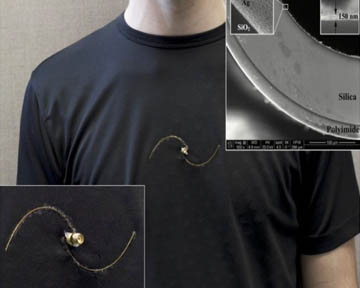
Prototype of the spiral antenna integrated into a cotton shirt. Upper-right inset shows SEM images of the multi-material fiber structure. [Image: Université Laval] [Enlarge image]
During the hot summer months, breathable cotton tops, marketed for their ability to keep the torso cool, become a popular clothing item. Now, researchers at Université Laval, Canada, have created a “smart T-shirt” that monitors the wearer’s respiratory rate in real time, giving new meaning to the term “breathable clothing.” According to the research team, the high-tech attire could be used to diagnose respiratory illnesses or sleep disorders, such as sleep apnea or chronic obstructive pulmonary disease (Sensors; doi: 10.3390/s17051050).
Worn, not attached
Many methods to measure respiratory rate need wires, electrodes or sensors that attach to the subject’s body (think of an electrocardiogram, which uses chest electrodes to measure breathing rate.) Diagnosing obstructive sleep apnea, for example, requires an overnight sleep study, or polysomnogram, in which the subject is hooked up to wires and sensors and monitored by technologists—all night long.
In the Laval’s team concept—led by Younes Messaddeq of the university’s Center for Optics, Photonics and Lasers—no wires, electrodes, or sensors attach to the user’s body. Instead, to measure respiration rates, a small spiral antenna is sewn into the cotton shirt at chest level. The antenna comprises multi-material fibers consisting of polyimide-coated hollow-core silica glass capillaries; the team used cyanoacrylate glue, a reasonably flexible substance, to integrated the fibers into a 20×10-cm cotton patch for off-body testing and into a cotton t-shirt for on-body measurements.
Chest expansion (when breathing) allows the antenna to slightly stretch—although the authors stress that the stretching does not cause “any elongation or deformation of the metal-glass polymer fibers themselves, only the radii of the spiral.” As the subject breathes in, the changing geometry of the smart-fiber antenna leads to a “significant shift” in its resonant frequency, which in turn can be tied to changes in thorax circumference and the increased volume of air filling the lungs.
Because of the antenna’s sensitivity, says team leader Messadeq, “the T-shirt doesn’t need to be tight or in direct contact with the wearer’s skin. The oscillations that occur with each breath are enough for the fiber to sense the user’s respiratory rate.” Moreover, according to Messaddeq, the group’s tests “show that the data captured by the shirt is reliable, whether the user is lying down, sitting, standing or moving around.”
Spiral antenna in a spin cycle
For a high-tech shirt to have an extended lifecycle, it needs to be durable. To test the durability of its invention, the Laval team put the antenna-equipped T-shirt through a washing machine—not once, but 20 times. “After 20 washes,” says Messaddeq “the antenna had withstood the water and detergent and was still in good working condition.”
Such durability is crucial, since, as Messaddeq points out in a press release on the invention, the antenna “does double duty” in both sensing and transmitting respiratory data. This data, the authors propose, could be transmitted wirelessly to mobile devices or computers through the very same fiber antenna. In future work, the team will focus on adapting the technology to measure the breathing of newborn infants, where comfort is a priority for such minute lungs.
